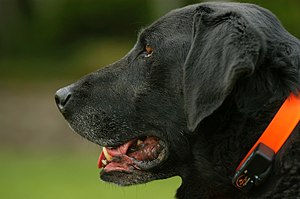 Image via Wikipedia
Image via Wikipedia
Tony had the staples from his surgery out yesterday, and, unfortunately that was the high point of our day. It started when he turned up his nose at his food. All dogs spurn their food now and then, but when the dog is diabetic, it causes problems. Our appointment was at 11:45, and he still hadn't eaten by the time we were to leave. This meant that it would be at least an hour and a half before he could eat and have his shot. I tried everything I could think of, but he just wasn't interested. In the past, he has occasionally not eaten in the morning at all, and it seemed this was one of those days. It was frustrating for me, though, since I knew that the vet visit was going to put some added stress on him, which can affect blood sugar. Even worse, the vet wanted to keep him for a few hours because she was having trouble getting a urine sample.
I was relieved when she called to say that I could pick him up (by this time it was 3PM-- a long time to go without food), and I figured that I could get him home by 4 and set him up with an early dinner. Alas, it was not to be.
It was a hot day, and I had been running errands while waiting for her call. When I went out to my car and started it, the oil light and electrical light both stayed on. AARGH! I checked the oil -- it was fine. I got out the manual, read up on both lights, decided that a. I couldn't do anything about this myself, and b. I couldn't drive the car without running the risk of ruining my engine. And things didn't get any better. My sister was going to drive me, so I needed to clean out Tony's carrier (he rides in a car seat in my car, but it couldn't fit on the back seat of her car). I discovered that my brother, who had borrowed the carrier a while back for a truly obnoxious Schipperke puppy he had at the time (the pup ate a huge hole in his kitchen linoleum, and that was just the tip of the iceberg), had forgotten to tell me that his chewing machine had been at work on the carrier. It was a mess. I washed it out, put it back together, and realized that I had to put the door in while it was apart. I had broken three nails getting it apart in the first place, and I was in a hurry, and I discovered that I couldn't get the clamps off again. AARGH! AARGH! (yes, that's a double AARGH). I'm ashamed to admit that I burst into hysterical tears.
The upshot of the whole deal was that my sister went by herself (with the car seat) and left me at home to recover (thanks, Leslie). After some sleep, I felt that I could maintain again. But he did it again! Right now, I'm typing this with his untouched bowl sitting next to me, it's 11:30, and he's taking a little nap. About an hour ago, I offered him a Liv-a-Snap (something he gets very rarely), hoping to "prime the pump," so to speak, but it was not to be.
Priming the pump actually works a lot of the time. It's as if the dog doesn't realize he's hungry, and a special treat reminds him. The problem with treats is that you're trying to control what he eats -- the carbs, the protein, and the fat -- and you really don't want to screw that up. When he won't eat, I sometimes think that he's holding out for the treat he gets after his shot (I use freeze-dried lamb lung slices for that; he doesn't get them at any other time, and they seem to be highly addictive). He hasn't quite gotten the idea that he can't have the shot and get the lamb lung unless he eats his food. And sometimes, it's as if he needs to make room for food: he wants to go out in the yard and empty the tanks before he eats. I thought he was doing that just now, but no such luck. He came back in, raring to go, sniffed at the food and walked away. It's pretty annoying, since I need to take the car in asap. Well, he'll eat or he won't. He's had enough disruptions to his routine the last few weeks to put anyone off eating, so I'm not going to panic. The bottom line, I guess, is that you have to be flexible, if you can.
![Reblog this post [with Zemanta]](http://img.zemanta.com/reblog_e.png?x-id=d47e6dd1-84e5-481d-9551-28ebe8ff06d3)










![Reblog this post [with Zemanta]](http://img.zemanta.com/reblog_e.png?x-id=2bac5f77-74bf-4ad9-839f-580e10708307)
![Reblog this post [with Zemanta]](http://img.zemanta.com/reblog_e.png?x-id=e5295677-47fe-409e-a59c-9e41e6bc65ae)

![Reblog this post [with Zemanta]](http://img.zemanta.com/reblog_e.png?x-id=d47e6dd1-84e5-481d-9551-28ebe8ff06d3)
![Reblog this post [with Zemanta]](http://img.zemanta.com/reblog_e.png?x-id=62526f33-7c57-4141-ad81-24e5dbcedb8a)
![Reblog this post [with Zemanta]](http://img.zemanta.com/reblog_a.png?x-id=fbf6eea6-3374-496c-a52c-da1b81262231)






